 zachary harden
zachary harden
Keywords: ufe | unidentified flags | 2019 |
Links: FOTW homepage | search | disclaimer and copyright | write us | mirrors

Last modified: 2025-02-07 by  zachary harden
zachary harden
Keywords: ufe | unidentified flags | 2019 |
Links: FOTW homepage |
search |
disclaimer and copyright |
write us |
mirrors
Please note our Policy for Submissions and Enquiries.
Below is a series of images of flags that have been provided to FOTW; some we have recognized, and some we have been unable to recognize. If you can help us identify any of these flags, please let us know! Contact the: UFE Editor.
Identification Key:
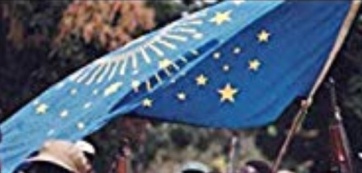 Image from Jason Saber, 24 August 2019
Image from Jason Saber, 24 August 2019
This book cover was posted on the Facebook page. (full cover image). According to the back cover, the image depicts South Sudanese troops but there is no information on the distinctive flag on show. The book was published in 2000. Thought you'd like to see it,
Jason Saber, 24 August 2019
We don't show this flag in either our South Sudan or Sudan pages - does anyone recognize it?
Rob Raeside, 24 August 2019
This flag is from the military wing of the Badr Organization.
Jaume Ollé, 31 August 2019
The entry from the front cover of the book Encyclopedia of Modern Separatist Movements by Christopher Hewitt and Tom Cheetham, published in the year 2000. The flag in question, as quoted by the book is as follows: "Photo Credit: Soldiers from the Sudan People's Liberation Army (AP Photo/John Cobb)" (original photo) (restricted access source) The flag is a blue background with one big yellow five-pointed star, with multiple yellow sun beams and spread all over the background are also multiple five-pointed yellow star. On the canton it displays three capital yellow letters unidentifiable. (source)
It is important to notice that even though the flag in the book is identified as that of the Sudan People's Liberation Army, in our section, its flag is very different. That movement is also known to change its symbols often, so it shouldn't be a surprise that this was its first or one of its earliest flags. There's also the possibility that its a flag of one of its many factions.
Esteban Rivera, 31 August 2019
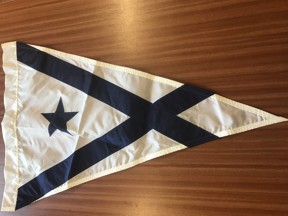 Image from Jennifer Whyte, 26 August 2019
Image from Jennifer Whyte, 26 August 2019
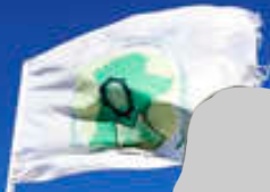 Image from William Garrison, 14 August 2019
Image from William Garrison, 14 August 2019
Unknown Shi'ite militia flag - caption reads "Masked Shiite fighters hold their weapons in Al Hadidiya, south of Tikrit, Iraq, March 6, 2015. (photo by REUTERS/Thaier Al-Sudani)" (source)
William Garrison, 14 August 2019
As Jaumé already pointed out, those flags are of The League of the Righteous and Badr Organization. Regarding the latter, we feature only its military wing flag, but the umbrella organization's flag is the one that is mentioned by William Garrison, and feature's its logo in the middle of a white horizontal background.
Esteban Rivera, 31 August 2019
 Image by Pete Loeser, 14 November 2019
Image by Pete Loeser, 14 November 2019
Bill's original photo appears be of the reverse side of the Badr Organization's flag (with a fighter's head cut out), so I provide a speculative image of the obverse (front) side based on the Wikipedia image of their logo as noted by Esteban in his comments.
Pete Loeser, 14 November 2019
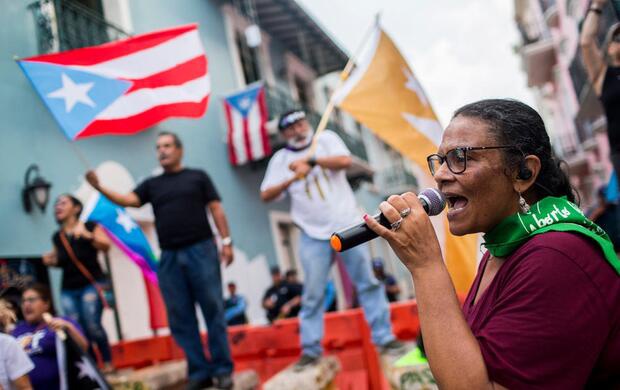 Image from Art, 28 September 2019
Image from Art, 28 September 2019
Take a look at this picture.
Art, 28 September 2019
What is the source?
Rob Raeside, 28 September 2019
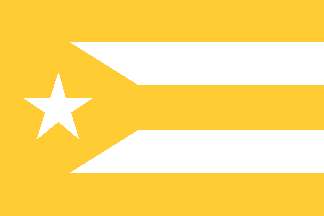 Image by Pete Loeser and Tomislav Todorovic, 29 September 2019
Image by Pete Loeser and Tomislav Todorovic, 29 September 2019
See "Vexibits for August 2019" for the answer. This flag symbolize all victories of Puerto Ricans on and off the island, and Carlos Morales-Ramirez will be pleased to see it in cloth.
Pete Loeser, 29 September 2019
Here is another photo of this flag. The accompanying text says: "Our Golden Flag, sublime symbol of the New Puerto Rico determined to take charge of its future once and for ever."
The flag was created in 2016 for an advertising campaign from Open Mobile, a cell phone company in Puerto Rico, after Monica Puig won the gold medal in tennis in the 2016 summer Olympic games in Rio de Janeiro, which was the first Olympic gold medal ever won by Puerto Ricans. The flag has since become an established symbol of victory. The design was originally used in the street murals, which still seem to be the most common way of its use, often appearing together with the national flag and the black Puerto Rican flag, but as can be seen, there are also examples of its use as a real flag. Consequently, the flag color is gold, not yellow.
Sources: [1] Carlos A. Morales-Ramirez: Variant Flags of Puerto Rico: Red, White, Blue...and Black, and Gold? The Vexilloid Tabloid, Portland Flag Association bulletin, ISSN 2474-1787 Issue #77, August 2019 and [2] El Punto Medio website.
Tomislav Todorovic, 29 September 2019
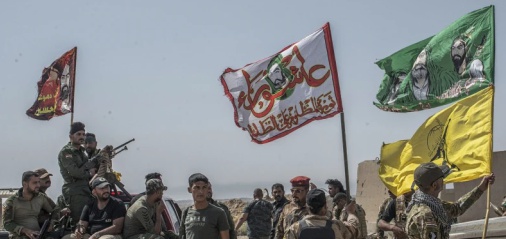 Image from William Garrison, 29 September 2019
Image from William Garrison, 29 September 2019
Three unidentified flags here. Flags, Iraq, yellow Hizballah flag, and 3 unidentified Shia/Shiite-Muslim "Imam Hussein/Hosein" religious flags. (source c. Aug. 19, 2019)
William Garrison, 29 September 2019
 Image from Klaus-Michael Schneider, 1 October 2019
Image from Klaus-Michael Schneider, 1 October 2019
This banner of arms is fixed by a red tube on the pole.
Banner #1 Description: (portcullis, ship, trees and wolf) quarterly divided, 1st and 4th quarter Vert a chained portcullis Or, 2nd and 3rd quarter Azure, an ancient ship Or rigged Argent and flagged Gules, over all a fess Or, charged with three connected trees proper (i.e. Vert stemmed Maron, a demi-wolf Argent passant coming out of the trees at dexter,the banner is surrounded on three sides by a black and white bordure.
I spotted banner #1 on 7 September 2014 in the Cathedral of Cardiff.
Klaus-Michael Schneider, 1 October 2019
This one is the banner of Jame Callaghan [James Callaghan (1912-2005)], former Prime Minister, later Baron Callaghan of Cardiff. It's probably relevant that both Sir Jame Callaghan and Sir Cennydd Traherne were Knights of the Garter.
Jonathan Dixon, 17 October 2019
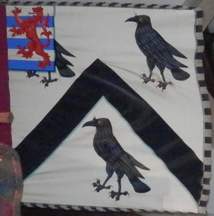 Image from Klaus-Michael Schneider, 1 October 2019
Image from Klaus-Michael Schneider, 1 October 2019
This banner of arms is also fixed by a red tube on the pole.
Banner #2 Description: (chevron and ravens) Argent a chevron Sable, flanked by three ravens trippant of the same, the raven in canton is superimposed by a rectangle barry of six of Argent and Blue, charged with a lion rampant Gules, the banner is surrounded on three sides by a black and white bordure.
I also spotted Banner #2 on 7 September 2014 in the Cathedral of Cardiff.
Klaus-Michael Schneider, 1 October 2019
Banner #2 is that of Sir Cennydd Traherne [Cennydd George Traherne (1910-1995)], a Welsh nobleman who was once Lord Lieutenant of Glamorgan.
Dirk Schönberger, 1 October 2019
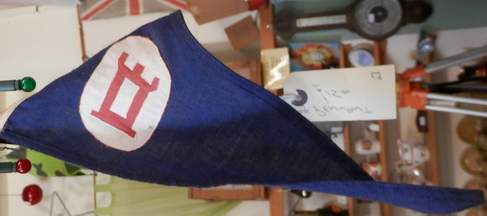 Image from Klaus-Michael Schneider, 1 October 2019
Image from Klaus-Michael Schneider, 1 October 2019
Banner #3 is a blue pennant with white disc at hoist, charged with a red, embattled voided tower, probably belonging to a British yacht club. I spotted this pennant on 9 September 2014 in an antiques shop in Pembroke (Wales).
Klaus-Michael Schneider, 1 October 2019
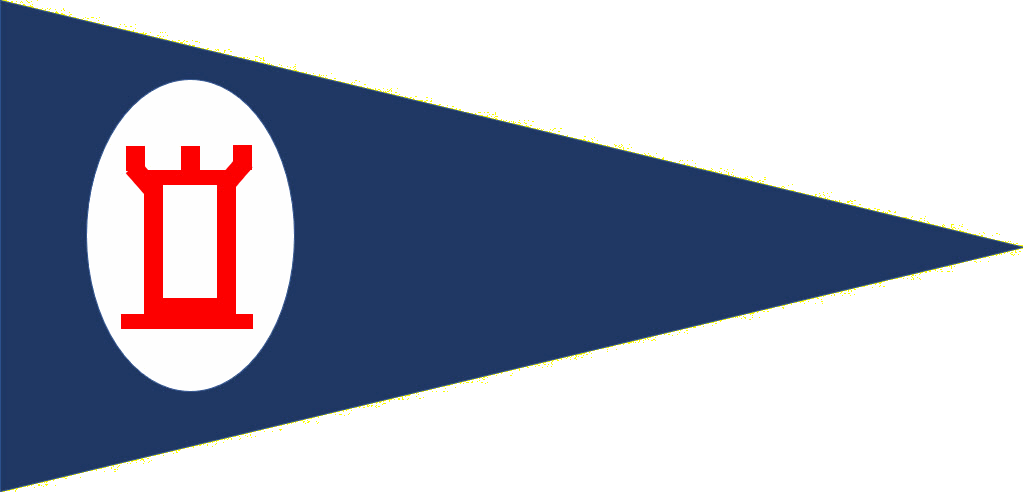 Image from Pete Loeser, 24 October 2019
Image from Pete Loeser, 24 October 2019
I made this quick drawing to attempt an image search -it failed - but perhaps the image will help somebody else ID it. Sadly, I could not find anything else about it.
Pete Loeser, 24 October 2019
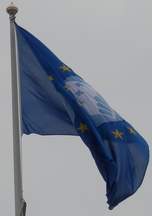 Image from Klaus-Michael Schneider, 1 October 2019
Image from Klaus-Michael Schneider, 1 October 2019
The flag was hoisted on top of the Chichester District Building on 5 September 2014, thus it is actually English and not Welsh. The flag is a Europe flag with a celestial blue disc between the stars, charged with a white building. The building does not match the logo of the District Council, and due to strong winds I couldn't fix the whole building. It might be an image of the clock tower on the local market cross, which has however just three visible arches, and the building on flag has five of them.
Klaus-Michael Schneider, 1 October 2019
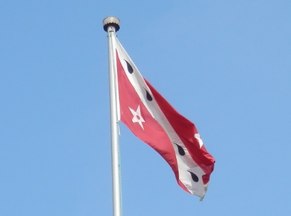 Image from Klaus-Michael Schneider, 1 October 2019
Image from Klaus-Michael Schneider, 1 October 2019
This one might probably be an IFE [Identified Flag or Ensign?]. I had to completely reconstruct, where I spotted this flag. It happened on 12 Sep 2014 in Bangor. The Church wasn't particularly big, but images from the WWW confirmed that it is the "Cathedral of Bangor." My complete image shows the clock of the tower, topped by a red mitre with yellow scarves. Thus I guess, this is the banner of arms of the Diocese of Bangor within the Church in Wales.
Here is the pattern: Gules a bend Argent gutty of pitch (Guttè de poix) and flanked by two mullets of the same.
I hope, the number of pitch drops doesn't matter. The flag I spotted had four drops, Wikipedia displays nine drops, the website of the local St. Daniel's Cathedral displays seven drops. If it matters, we have one UFE more. Can anybody assist?
Klaus-Michael Schneider, 1 October 2019
Doing a little bit of digging, it does seem that the flag belongs to the Diocese of Bangor. According to it the arms were granted in 1512 and it seems the Wikipedia artist decided on the number of drops as a stylistic choice. (Note, many arms on Wikipedia use the public blazon to make their own versions to avoid any copyright concerns). Even the College of Arms did not note on how many drops are supposed to be present; "Gules, a bend Or guttee-de-poix between two pierced mullets argent" was the official blazon given by the College of Arms. It also seems we cover this flag already at Diocese of Bangor.
Zachary Harden, 20 June 2020
You have given confirmation, that the number of drops didn't matter. I had thus decided last year to consider that flag as identified, as I had already found images with different numbers of drops. Seems the only thing to do would be embedded the blason of the College of Arms.
Klaus-Michael Schneider, 20 June 2020
ciwsd.jpg) Diocese's Website image
Diocese's Website image
 #51a
#51a
Images from Esteban Rivera, 21 June 2020
A little addition to this already positively identified entry: the official number of drops is seven, as seen on the Diocese's official website. (image)
Also, in order to confirm the above, here's another picture displaying the flag with seven drops (cropped image from the original image). Picture caption reads: "Bangor Cathedral, north Wales
Contributor: Richard Iestyn Hughes / Alamy Stock Photo Date taken: 7 September 2012
Location: Bangor, Gwynedd, Wales, UK"
However there seems to be "alternative" designs (unofficial), as this Coat-of-Arms displays 14 drops
Esteban Rivera, 21 June 2020
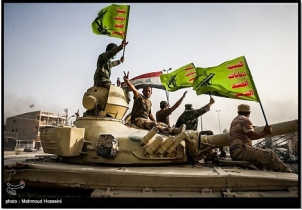 Image from William Garrison, 1 October 2019
Image from William Garrison, 1 October 2019
A unknown militia flag, mixed within Popular Mobilization Forces (PMF), c. April 2018 (Hizbollah-similar flag. (source)
William Garrison, 1 October 2019
 Image from Albert S. Kirsch, 13 October 2019
Image from Albert S. Kirsch, 13 October 2019
The pre-Baath Syrian flag being flown by a Kurdish or Arabic refugee in Turkey. The script reads something like hriya?.
Albert S. Kirsch, 13 October 2019
The inscription on top in Arabic reads: حرية (freedom) It is simply a makeshift flag and by no means is official in use. That being said, it is what one might call a "supporter" flag in the sense of supporting the opposition against the current regime during the ongoing Civil War.
In turn, it is the Syrian Republic.
The Syrian Republic (First Syrian Republic) was formed in 1930 as a component of the French Mandate of Syria and Lebanon, formally established by the Syrian State Constitution (in French: Constitution de l'Etat du Syrie), proclaimed on May 14, 1930. The flag was enacted as follows: "Article 4 - The Syrian flag is arranged as follows: Its length is twice its height. It includes three stripes of the same dimensions. The upper stripe is green, the middle white, the lower black. The white part includes three red stars aligned with five points each" (in French: Art. 4 – Le drapeau syrien est disposé de la façon suivante: Sa longueur est le double de sa hauteur. Il comprend trois bandes de mêmes dimensions. La bande supérieure est verte, la médiane blanche, l’inférieure noire. La partie blanche comprend trois étoiles rouges alignées à cinq branches chacune.) (source).
The Frencha Mandate of Syria and Lebanon 1923-1946 (in French: Mandat pour la Syrie et le Liban 1923-1946; in Arabic: الانتداب الفرنسي على سوريا ولبنان 1923-1946) was a League of Nations mandate (dated April 25, 1920) founded after the First World War and the partitioning of the Ottoman Empire concerning Syria and Lebanon. The term mandate is typically used to refer to a long-term international mission which has been authorized by the United Nations typically involve peacekeeping operations. The Mandate system was supposed to differ from colonialism, with the governing country acting as a trustee until the inhabitants would be able to stand on their own. At that point, the mandate would terminate and an independent state would be born. (source #1) and (source #2) [these sources can be added to the already mentioned ones (here).
"A treaty of independence was made in 1936 to grant independence to Syria and end official French rule, but the French parliament refused to accept the agreement. From 1940 to 1941, the Syrian Republic was under the control of Vichy France, and after the Allied invasion in 1941 gradually went on the path towards independence. The proclamation of independence took place in 1944, but only in October 1945 the Syrian Republic was de jure recognized by the United Nations; it became a de facto sovereign state on April 17, 1946, with the withdrawal of French troops. It was succeeded by the Syrian Republic (informally known as Second Syrian Republic) upon the adoption of a new constitution on September 5, 1950" (source)
Esteban Rivera, 7 May 2020
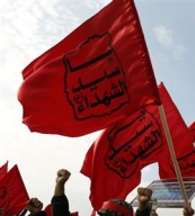 Image from William Garrison, 5 October 2019
Image from William Garrison, 5 October 2019
This is an unknown Basij militia flag seen in Iran c. 2015 (source)
The caption reads; "Iran's volunteer forces, Basij, are holding the second day of major military drills on November 20, 2015 on the outskirts of the central city of Qom."
William Garrison, 5 October 2019
This has been identified as a variant of the Upper Silesia State Flag.
This flag has been identified as that of the City of Wyk auf Föhr in Northern Frisia, Schleswig-Holstein.
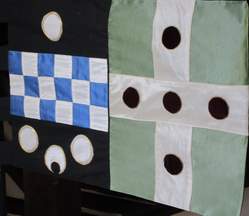 Image from Klaus-Michael Schneider, 19 October 2019
Image from Klaus-Michael Schneider, 19 October 2019
I spotted this one on 13 September 2019 in the Church St. Mary The Virgin in Hayes, which is part of Bromley (Kent). Can anybody identify this banner of arms? Description: Parted per fess, at dexter Sable a fess chequered of Azure and Argent (3x6), flanked by a plate in chief and a crescent Argent between two plates in base; at sinister Vert, parted by a Greek cross Argent, charged with five gunstones (or ogresses).
Klaus-Michael Schneider, 19 October 2019
I think it's intended to be the arms of the Pitt family. The Pitt arms are conventionally displayed with the roundels (which should be or, rather than argent) displayed 2, 1. The arms with the cross on vert are those of the Grenville family.
William Pitt, 1st Earl of Chatham, was a politician, and Prime Minister 1766-68. His wife was Hester Grenville. Pitt was the younger son of Robert Pitt, hence the crescent for cadency.
One of the Earl's sons was William Pitt the younger, who was born in Hayes in 1759. This Pitt likewise became a leading politician and was Prime Minister during the Napoleonic Wars.
Ian Sumner, 19 October 2019
You might be right with the torteaux, the balls may in fact be very very dark red. The pole however is on the "Pitt half", and it was a flag hanging down from the pole.
Klaus-Michael Schneider, 13 November 2019
 Image from William Garrison, 15 November 2019
Image from William Garrison, 15 November 2019
A green flag of an unknown Iraqi militia (image appears to be the Golden Dome of Shiite Imam Hussain) - c. March 2019. (source)
William Garrison, 15 November 2019
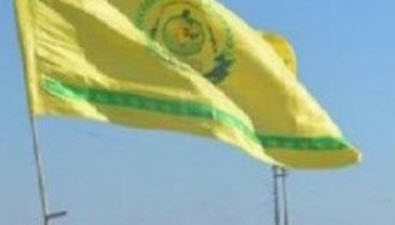 Image from William Garrison, 15 November 2019
Image from William Garrison, 15 November 2019
Elements of an unknown IRGC (Iranian Revolutionary Guards Corps) affiliated militia pose with their flag in Deir Ezzor, Syria. (Photo courtesy of Jamil al-Abed) c. May 23, 2019. (source)
William Garrison, 15 November 2019
Has anyone notice the similarity between this flag and that of UFE20-25? They are both basically the same design, color, and shape. Could they be variants of the same flag?
Pete Loeser, 5 September 2020
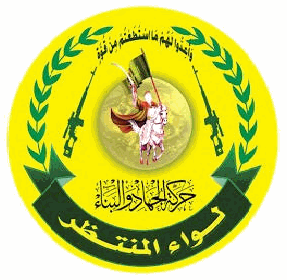 detailed emblem #59a
detailed emblem #59a
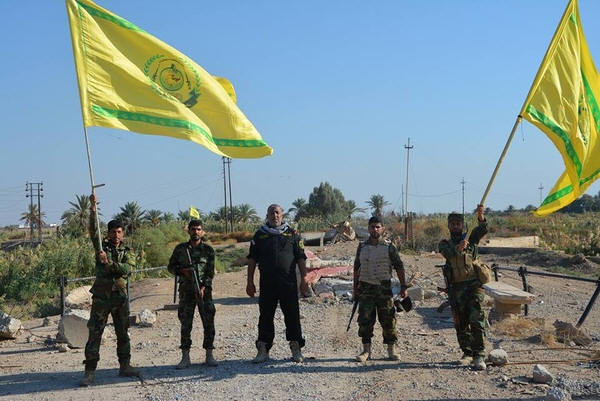 #59b
#59b
Images from Jaume Ollé, 18 July 2020
These are both flags of the Liwa al-Muntaẓar (Catalan: Les Brigades del Esperat, English: The Expected One's Brigade), also transliterated as Liwa al-Montadhar - لواء المنظر.
The Expected One's Brigade' name is for the 12th Shi'a Imam: Imam Mahdi. As Saraya al-Jihad, Liw al-Muntazar is affiliated with Harakat al-Jihad wa al-Bina'. It is operational south of Bagdad and in Babil and Anbar provinces.
I created a good images that will be distributed in next days in The Flag Report, together with dozens of flags of Shiite militias.
Jaume Ollé, 5 September 2020
I spotted these in a restaurant in Camarthen in 2014. And I believe, those had been images of real British military colours, no artwork. Image #60 probably shows a King's Colour of the Regiment, red with golden dragon and motto "CYMRU AM BYTH" (Wales forever). Image #60a shows one of nine older rounded pennants , probably referring to the same regiment. There had been nine of those pennants, only different in the Welsh motto and in the arms at hoist. And there had also been a probably newer regimental colour, having a yellow shield with a red lion in centre and a red number "V" in a yellow scroll beneath.
Can anybody assist, to which regiment they belong? If possible, I need images of the companies 1-3 of the group of nine (couldn't be spotted proper due to an orchard before the image. Thanks in advance!
Klaus-Michael Schneider, 11 November 2919
Both flags belong to the Welsh Guards. The first (#60) is a Queen's Colour of the regiment's First Battalion. The second flag (#61a) is a the standard of 9 Company. I've added a plate depicting the standards of 1-4 Companies in the files area of the Group website. [Plate was not attached - Ed.] The arms are the hoist are different for each company, and are those attributed to various Welsh kings and princes. The fly of each flag is the same, except for the company number in Roman numerals and motto.
Ian Sumner, 11 November 2019
This (#60) is a Queen's Colour of 1st Battalion, Welsh Guards, from the 1960-80 period. It contains Second World War battle honours, but not the 1982 Falkland Islands battle honour.
This (#60a) is the "Company Colour" of No. 9 Company, Welsh Guards. They are quite small, about 70 cm. long. A Google search of "Welsh Guards" and "company colour" will find images for companies 1, 3, 8 and 9 (which are, I think, the remaining extant companies.) Both of these images are official watercolour prints of the real flags.
T.F. Mills, 11 November 2019
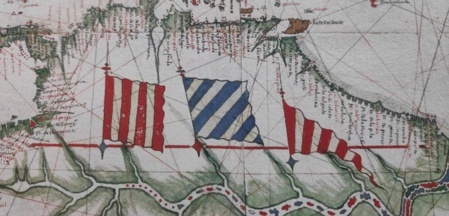 #61
#61
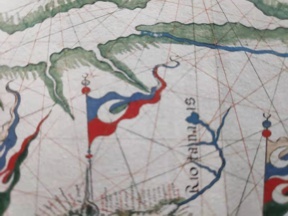 #61b
#61b
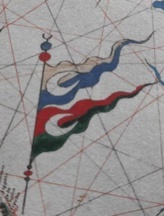 #61c
#61c
 #61d
Images from Ângela Gil, 12 November 2019
#61d
Images from Ângela Gil, 12 November 2019
My name is Ângela Gil and I'm a special collection librarian currently working at the Library of Macau University of Science and Technology.
Our Library has a long-term ongoing project, Global Mapping of Macao (GMOM), that since 2013 aims to develop a special collection not only on maps but also plans, charts, landscapes, drawings, etc. - by purchase or facsimile- with special focus on Macao. The digital reproductions would be included in our GMOM project here.
As I am now dedicating all my working time to the study and research on maps your website has been of great help, thank you. Actually I saw the flags from a Port Olan chart by Fernão Vaz Dourado you have "identified" which were of great use to us. However I'm contacting on the hope to get some help identifying some of the flags on a nautical chart by another Portuguese cartographer, Sebastião Lopes.
I send you the flags in question on attach but you can see the map in which they are present on our Library catalog website here
The attach of the Elmina Castle (#61a) - which is a Portuguese fortress in Africa and its representation is very common in Portuguese maps and charts - has a Portuguese flag I could easily identify but I can't identify the other two, although I'm mostly interested in the middle one.
There are two attaches of the Islamic-Arabic flags (#61b and #61c) that are scattered throughout the map, but I can find this exact ones anywhere else or to what they mean and to whom this territories actually belonged.
The unidentified flags attach are of flags placed in North Brazil - and if you see the link I send above - are also present in south North America. I know they are of Portuguese and Spanish colors but for other areas on the map owned by those two countries the author used the already known flags. I have also seen this flags on other Portuguese maps of this period but I can never identify them or their meaning. I found strange that as they appear so much no one has studied them before. Are they from a Portuguese commercial trade company? Do they have a special meaning for those territories? Are they shared territory?
Ângela Gil, 12 November 2019
I think those with the crescent moon are likely fictitious, using generic Middle East symbolism.
Rob Raeside, 11 November 2019
I don't have a perfect match for your quartered flag at Elmina Castle, but that banner might be a modification of the personal arms of Vasco da Gama. See more details on our page here. It displays the flag of Sines in Setubal District with the following text: "The base of this shield of arms was taken from the family arms of Vasco da Gama, Sines' most renowned son. They were checkered of three pales and five fesses, Or and Gules two fesses argent (see putative banner of these arms). Vasco da Gama himself received as an honourable augmentation an inescutcheon of Portugal ancien (as depicted, f.i., here and here)" - posted by António Martins, 11 January 2008.
Klaus-Michael Schneider, 13 November 2019
This has been identified as the flag of the State of Aden, and part of FOTW archives.
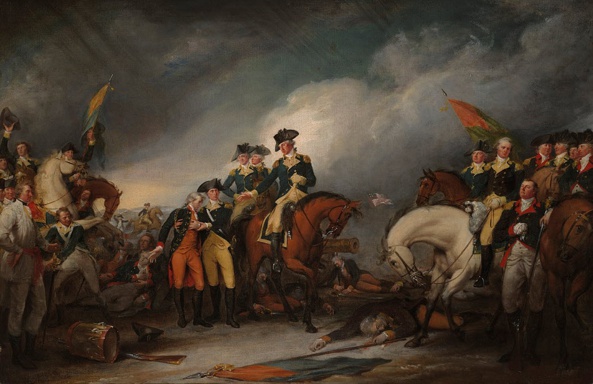 Image from Mahmood Khan, 18 December 2019
Image from Mahmood Khan, 18 December 2019
I have a flag identification question. In Trumbull's "Capture of the Hessians at Trenton" it appears Washington's troops are flying a blue banner with a red canton. Is this a unit flag or a variant USA flag?
Mahmood Khan, 18 December 2019
I've always interpreted these as generic stylized American unit colors, as opposed to specific unit colors.
Jim Ferrigan, 19 December 2019
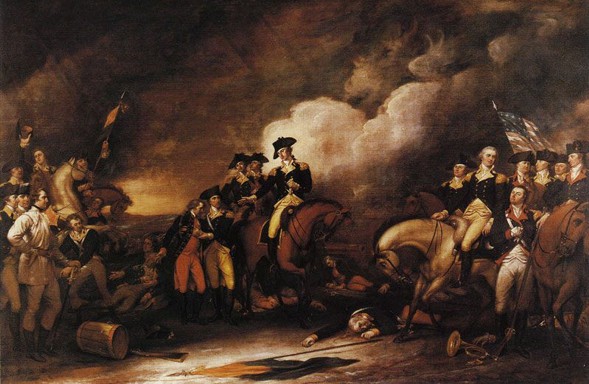 Image from Dave Martucci, 20 December 2019
Image from Dave Martucci, 20 December 2019
Trumbull painted several versions of this scene. The flags vary from copy to copy. I don't think they were intended to be accurate examples of any specific flag. For example, this version was painted in 1831 and is located at the Wadsworth Atheneum Museum of Art, Hartford, Connecticut.
Dave Martucci, 20 December 2019
I concur with Dave and Jim. Trumbull painted the earliest version in London in the 1790s, long after the event, and the flags are basically dramatic embellishments. The same is true of his other historical paintings.
Peter Ansoff, 21 December 2019